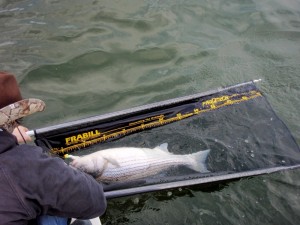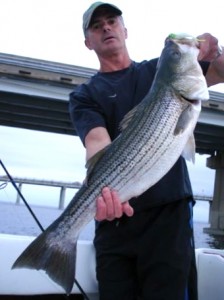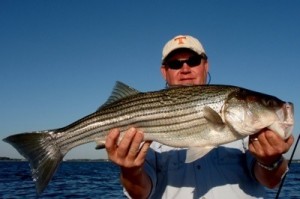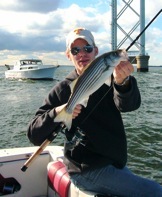jigging
 Gone are the fair-weather boaters with their blaring radios and boats bristling with broomsticks. No more planer-board trollers claiming 300 foot right-of- ways, or obnoxious broadcasters insulting everyone with a VHF radio within 50 miles. Catch & release season is the time of year when the one-man-one-rod concept reigns supreme. It’s when you can run on-plane for miles in the wide-open Bay and never see another fishing boat. A time when there’s very little competition for prime fishing spots, and a small but tight fraternity of hard-core fishermen brave the elements to jig the cold-weather hotspots. I anticipate the start of C&R season like a kid waits for Christmas.
Gone are the fair-weather boaters with their blaring radios and boats bristling with broomsticks. No more planer-board trollers claiming 300 foot right-of- ways, or obnoxious broadcasters insulting everyone with a VHF radio within 50 miles. Catch & release season is the time of year when the one-man-one-rod concept reigns supreme. It’s when you can run on-plane for miles in the wide-open Bay and never see another fishing boat. A time when there’s very little competition for prime fishing spots, and a small but tight fraternity of hard-core fishermen brave the elements to jig the cold-weather hotspots. I anticipate the start of C&R season like a kid waits for Christmas.
My sons Jacob and Daniel are visiting from Tennessee this week. We’ve been trying to work a fishing trip into our schedule, but we couldn’t get it all together until today. Read More!
 Big fish are rare in mid-September, so it’s somewhat surprising that we’re turning up a few. I’ve had at least one fish over thirty inches long in each of my last six jigging trips to the Bay Bridge. As long as that’s happening, there’s no need to fish anywhere but right here at home. I made it out to the bridge the past three evenings. The water has cooled to the mid-70s and the recent unsettled weather has the fish thinking about feeding up for the winter. Tuesday, my friend Rich was nice enough to pick me up below the bridge on my way home from work. The tide was slack when we started, but picked up to a strong flow just before dark. We broke the 30 inch mark on two fish, lost a couple more when they wrapped around the pilings and broke off, and I hooked into something huge and slow. It might have been a skate, but it felt more like a fish, possibly a big drum. Read More!
Big fish are rare in mid-September, so it’s somewhat surprising that we’re turning up a few. I’ve had at least one fish over thirty inches long in each of my last six jigging trips to the Bay Bridge. As long as that’s happening, there’s no need to fish anywhere but right here at home. I made it out to the bridge the past three evenings. The water has cooled to the mid-70s and the recent unsettled weather has the fish thinking about feeding up for the winter. Tuesday, my friend Rich was nice enough to pick me up below the bridge on my way home from work. The tide was slack when we started, but picked up to a strong flow just before dark. We broke the 30 inch mark on two fish, lost a couple more when they wrapped around the pilings and broke off, and I hooked into something huge and slow. It might have been a skate, but it felt more like a fish, possibly a big drum. Read More!
 Memorial Day Weekend marks the start of summer for many Chesapeake boaters, but it means a slow-down in fishing for those of us who have been out all along. All the boat traffic on the Bay can put the fish in hiding, but it’s a tough time of year no matter what. Many anglers blame the slow fishing on may worms. May worms, also called clam worms, live on the shell bottoms of the bay and swarm during late May. The reddish worms can be up to 5 inches long and develop small swimming fins to propel them up from the bottom when they mate during the dark of the moon. I guess they are a tasty treat for rockfish. Some fish you catch this time of year area actually yellow or red tinged because of all the may worm gorging. Read More!
Memorial Day Weekend marks the start of summer for many Chesapeake boaters, but it means a slow-down in fishing for those of us who have been out all along. All the boat traffic on the Bay can put the fish in hiding, but it’s a tough time of year no matter what. Many anglers blame the slow fishing on may worms. May worms, also called clam worms, live on the shell bottoms of the bay and swarm during late May. The reddish worms can be up to 5 inches long and develop small swimming fins to propel them up from the bottom when they mate during the dark of the moon. I guess they are a tasty treat for rockfish. Some fish you catch this time of year area actually yellow or red tinged because of all the may worm gorging. Read More!
 Have you ever wondered why fish seem to turn on and off at different times during the day? If you’re like me you’ve probably gone for hours without catching a fish, hardly even getting a strike. Then, click, just like turning on a light switch every cast results in a fish. Fishermen refer to this phenomenon as “the bite,” as in, “The bite turned-on about 3:00 PM and off at dark.” Read More!
Have you ever wondered why fish seem to turn on and off at different times during the day? If you’re like me you’ve probably gone for hours without catching a fish, hardly even getting a strike. Then, click, just like turning on a light switch every cast results in a fish. Fishermen refer to this phenomenon as “the bite,” as in, “The bite turned-on about 3:00 PM and off at dark.” Read More!
 Following up the previous article on basic vertical jigging techniques, I want to share what I know for kicking it into the next gear. Most of these methods are a natural progression from vertical jigging. Jigging is an extremely productive method for catching Chesapeake Bay rockfish, so it’s something you’ll want to practice and learn well.
Following up the previous article on basic vertical jigging techniques, I want to share what I know for kicking it into the next gear. Most of these methods are a natural progression from vertical jigging. Jigging is an extremely productive method for catching Chesapeake Bay rockfish, so it’s something you’ll want to practice and learn well.
Most of my techniques have been honed over time by bass & striper fishing in fresh water situations. Bay fishing is similar in many respects, but there some special considerations.
The Chesapeake Bay is very shallow compared to many striped bass environments. While suspended fish are occasionally encountered, it’s more likely that they are either feeding on the surface or holding near the bottom. Read More!
 One of the most effective techniques for catching striped bass in the Chesapeake Bay is vertical jigging with light tackle. It can be done in both deep and shallow water and will produce when all other methods fail. Rockfish in the Bay typically station themselves near underwater structure where they wait to ambush bait-fish. Since they often don’t move much it’s necessary to present a lure exactly where they are holding. Jigging is the way to catch them.
One of the most effective techniques for catching striped bass in the Chesapeake Bay is vertical jigging with light tackle. It can be done in both deep and shallow water and will produce when all other methods fail. Rockfish in the Bay typically station themselves near underwater structure where they wait to ambush bait-fish. Since they often don’t move much it’s necessary to present a lure exactly where they are holding. Jigging is the way to catch them.
Basic vertical jigging technique requires stationing the boat directly over the fish. I never drop a jig unless I’ve either located fish on the finder, or feel confident that they’ll be nearby at any moment. Make no mistake, learning to find the fish is the hardest part of light tackle fishing. Read More!


